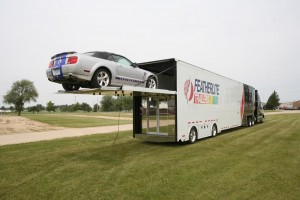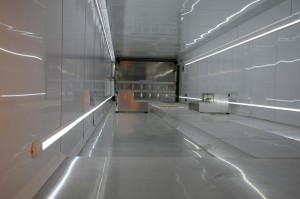While most fans watch NASCAR races to see flashy stock cars moving at high speeds, that’s only the tip of the iceberg that is a NASCAR race. Every driver in NASCAR has an enormous race team supporting him or her, including mechanics and engineers with PhDs using sophisticated instruments that would be more at home in NASA laboratories or a Tom Clancy novel. Their sole purpose is to give the driver the slightest winning edge over the rest of the teams in the race, and they do this by making adjustments to the car based on the data the team receives from the cars’ performance in the practice laps.
Engine parts will be altered, tested on the track, and altered again until the racecar is operating at peak performance. The support team has to be able to prepare the racecar for any kind of weather and any track condition, which means they have to have several different variations of the same part. If no variation exists, the team has to be able to create one on-site.
The nerve center of the modern race team is its car hauler, the tractor trailer that transports the team’s racecars and equipment to every track. These trailers have been designed to be the race team’s home away from home, with the capacity to do almost anything the team needs. The first modern semi car hauler was introduced to NASCAR in 1991 by race team owner Richard Childress, who commissioned a trailer for his driver, the legendary Dale Earnhardt. Childress and Earnhardt worked with Featherlite Trailers to create a trailer that could not only transport racecars but also serve as a mobile garage, a diagnostic center and a remote observation deck. Featherlite rose to the challenge, and the result revolutionized NASCAR races to the extent that Featherlite is still the official trailer of NASCAR.
One of the most impressive parts of a NASCAR car hauler is its lift gate, which also doubles as the trailer’s rear wall. The gate has been designed not only to load and unload racecars without upsetting the trailer’s balance but also to be as efficient as possible. Some lift gates, like those on race transporters manufactured by Featherlite Trailers, only require one person to open them.
Once the gate is lowered, the main area of the car hauler is visible—the work area. One of the first things you’ll notice is there is no wasted space. These car haulers need to carry much of the equipment that would normally be found in a professional garage. Cabinets fit together like pieces in a jigsaw puzzle, while equipment like rolling tool chests fit snugly in specially designed out-of-the-way cubbyholes.
Every spare part and diagnostic tool the race team owns is stored in the work area, from spare washers to spare transmissions, and even spare engines! As a result, the work area has cabinets of all shapes and sizes, from thin drawers to huge cabinets lined with versatile airliner tie down track.
The work area also highlights one of the subtler aspects of a racecar hauler—everything has been designed around items remaining secure during transport. Every cabinet and drawer in a car hauler is equipped with a spring-loaded latch that won’t accidentally open while on the road, and any stand-alone items like toolboxes are belted into specially-constructed storage spaces. Even the coffeemaker comes with a strap to keep the pot from moving! Many times, race transporters also have airliner tie down track installed on the floor to secure items ranging from tires to portable steps.
Despite the extra parts and tools the work area must carry, it also needs to have space for the race team to work. Race transporters come with at least two workbenches, as well as diagnostic stations for testing the car’s engine, battery and suspension components. Many race teams also design a manufacturing station for small car parts into their trailers in case of emergencies, and no race trailer or team would be complete without a coffeemaker! Most race teams also have a grill—and a designated cook—to keep the team fed throughout the race! The work area is outfitted with two air conditioners, and a pair of sliding doors can seal off the work area from the outside to help keep the cool air in.
Above the work area is the racecar storage area, or upper deck, which takes up the least amount of space on a standard semi car hauler. It makes sense if you think about it—most racecars don’t take up much room. Companies such as Featherlite Trailers measure the race team’s cars exactly to ensure the racecar fits snugly inside, but other car hauler manufacturers may make the upper deck an inch or two smaller than the cars so the work area has more space. The race teams then make the cars fit in the upper deck by releasing air from the tires. Since the racecar needs to be secured during transport, the upper deck also houses tie-downs for the car. The placement and type of these varies according to each race team’s desires, from D rings to airliner track.
The upper deck also holds other equipment such as ladders, and the area is usually lit by wall-mounted LED or fluorescent lights. If the race team needs to access the storage area, they roll-up the access door in the head room box leading to the lounge. Heavy-duty cleats installed on either side of the wall can be flipped down to enter the upper deck near the front of the car hauler.
The third section of the car hauler is usually called the lounge, but its true function is a multi-purpose meeting room that at different times will be a meeting area for the race team’s owner and sponsors, a control center where engineers analyze the racecar’s performance with the home garage, a locker room for the driver and occasionally a place to sit down and relax for a few moments between tasks.
Lounges are designed to the specifications of the race team, and as a result rarely are any two completely alike. Most have similar features, though. A flatscreen monitor is almost always installed, so engineers have a good, clear view of their racecar’s performance. During practice laps, race teams will hook the monitor up to the scoring and timing machines, which provide data for the race team’s car, but the competition’s cars as well. The monitor also lets the race teams keep an eye on the weather, gauge track conditions and judge the current performance of the car. Since the data gathered at the track must be shared with the engineers and mechanics at the race team’s headquarters, the lounges also have high-speed Internet access, as well as some desk space for the team to set up their computers. You’ll also find lots of cupboard space in the lounge. Some of it acts as locker space for the driver.
Some lounges have added amenities, like a kitchenette complete with a refrigerator and a second microwave oven. Another feature appreciated by many race teams is a radio/CD/DVD player that pumps out racetrack coverage or the local country station. A bathroom off the lounge is almost always a welcome convenience.
While racecar haulers might have their highest visibility in NASCAR, many other racing divisions rely on them as well. Many IZOD IndyCar drivers use semi racecar haulers. So do NHRA drag race teams, as well as the World of Outlaws Sprint Car Series!
When all is said and done, it’s probably a good thing that more people don’t know all that goes on inside race teams’ car haulers. Otherwise, the race itself might be abandoned in favor of watching what goes on in them!
